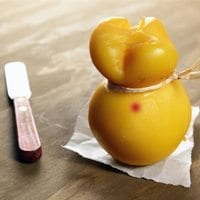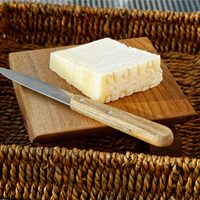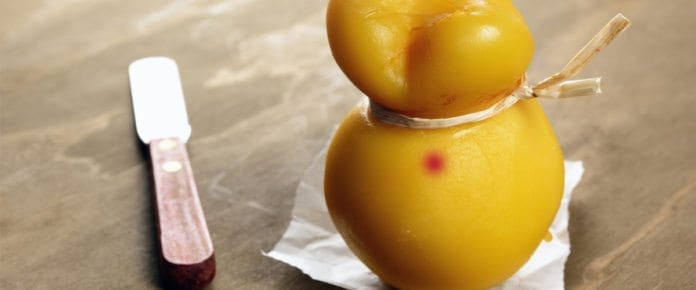By Mary Luz Mejia
 Scamorza
Scamorza
This stretched, cow’s milk cheese, which looks like a head covered in a bag tied with a rope, fittingly means “beheaded” in Italian. Its pear shape has been compared to provolone, as both have a rubbery texture, but Scamorza has more in common with a dry mozzarella. Made throughout Apulia, and in some parts of Molise and Campania, the cheese ripens for two weeks before it’s sold or smoked. Described as creamy, milky and piquant, it’s the go-to substitute for mozzarella as it’s got a deeper, sweeter flavour and is ideal for melting in baked dishes or for giving Italian recipes depth.
 Ricotta Salata
Ricotta Salata
The dried version of moist ricotta is found in traditional Italian dishes, such as lasagna, cheesecake and manicotti. It’s made in Sicily from the whey of sheep’s milk that’s pressed, salted and aged for 90 days. Firm and slightly salty and nutty, Ricotta Salata has been compared to feta, although it’s not nearly as crumbly. Shave or grate it over pasta, salad, grilled vegetables or any dish that needs a salty, savoury hit.
 Pecorino
Pecorino
The term Pecorino is used for Italian cheese made from 100-per-cent sheep’s milk. The most popular and widely used in North American restaurants is the D.O.P. (Denominazione d’origine Protetta) version called Pecorino Romano. Under European Union law, and as per D.O.P. requirements, it’s exclusively made in Sardinia, Lazio and in Grosseto, a Tuscan province. There are slight nuances in varieties, depending on how long the cheese has aged (usually eight to 12 months), but it’s all dry-salted by hand numerous times to deliver an intense, sharp flavour. The hard, granular cheese often replaces parmesan in dishes. It’s an excellent cheese to grate over pastas such as the Roman Cacio e pepe; to pile on foccacia and other breads; and to use in baked casseroles.
 Asiago
Asiago
Produced only on the Asiago plateau in the Veneto foothills of Italy, this D.O.P. (Denominazione d’origine Protetta) cheese, which used to be made from sheep’s milk, is now produced from unpasteurized cow’s milk. Fresh Asiago (or Asiago Pressato) is smooth in texture and less salty than its aged cousin, the Asiago d’allevo. The aged version (youngest is four months, oldest is two years) is more frequently consumed in Canada. Crumbly and similar in taste to full-bodied Parmesan, it adds a salty note when grated into salads, soups, sauces and over pasta.


















